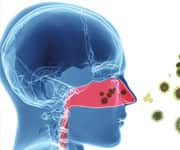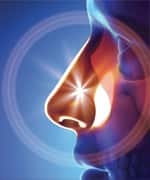Life Extension Magazine®

Ron Hunninghake, MD, chief medical officer of the Riordan Clinic in Wichita, Kansas, has devoted his career to the emerging paradigm of self-care: the patient as an informed medical partner. A family medicine physician and international lecturer, he was inducted into the Orthomolecular Medicine Hall of Fame in 2013. Hunninghake has authored or co-authored three books on inflammation, energy-boosting supplements, and how to stop prediabetes. However, it was his work on a clinical study on chronic sinusitis* that prompted us to sit down with him recently to discuss this widespread problem—and a novel solution.
LE: Sinus problems afflict 31 million Americans, who spend $1 billion annually on over-the-counter sinus products and $150 million on prescription sinus medications. What are the underlying causes of this condition?
RH: Have your readers examine their tongues in the mirror. There is a high probability that, like so many Americans, they will see a thick, white coating on their tongue. Coated tongues are common now. Why? Fungal yeast overgrowth. Candida was once upon a time just a minor player in the GI flora. Now 80 to 90% of our population unconsciously struggle with this major gut overgrowth organism. Why? Too much sugar and refined carbs in the standard American diet. Everyone is tired and looking for a quick boost. Why? Thyroid dysfunction secondary to over-fluoridation and excessive toxic metals such as mercury in amalgams. These “whys” could go on and on. So the real answer to your question is: There just isn’t one cause. There’s a cacophony of cascading triggers and environmental dysregulators.
LE: So modern environmental factors play a role in this cascade, correct?
RH: Environmental disruptions are now common in the Western population. Overprescribed antibiotics, over-utilized antihistamines, self-prescribed stomach-acid blockers leading to nutrient malabsorption, pervasive hormonal disruption, widespread sleep deprivation, outdoor air pollution, indoor air pollution contributing to nasal allergies and swelling, refined-food allergies and cravings, obesity-triggered cytokine stimulation with the effect of increased systemic inflammation, and mold overgrowth leading to more allergies and fatigue. Endless loops of cascading effects.
LE: Can you explain how exactly these factors are increasingly turning acute sinusitis into chronic sinusitis for so many?
RH: The microbiome of the human gut gets disrupted, so significant Candida overgrowth occurs not only in the gut, but also in the posterior nasal pharynx. Mess up the gut and general immunity gets suppressed. Inflammation flares and often over-responds, thus making the tendency for allergic responses more pronounced. Chronic nasopharyngeal swelling gets worse. Sinuses can’t and won’t drain. Then, a blocked sinus harbors persistent infection. Acute sinusitis becomes chronic sinusitis. Antibiotics stop working. A virtual tsunami of chronic sinus illness is invalidating the “take an antibiotic, a decongestant, and see me in a couple weeks” approach that used to work, some of the time.
LE: Antibiotics simply can’t keep up with the ongoing promotion of microbial infections, right?
RH: Right. Antibiotics are commonly prescribed for acute sinusitis but with limited benefits. But without addressing the underlying issues I just mentioned, antibiotics rapidly become useless in chronic sinusitis. Modern drugs do nothing for these root causes other than to actually make these situations worse. As noted by one surgeon regarding any infection, “Given the choice between better drainage and better antibiotics, I would choose better drainage every time.”

LE: Ideally, how would healthy sinuses naturally get rid of microbes and other irritants?
RH: The membrane lining of the sinuses secretes mucus and contains antimicrobial agents—such as antibodies—and is sticky in texture to capture small particles and infective microbes. Other protective mechanisms in the human sinuses include cilia, which are small, hair-like projections located in the nostril that normally beat in unison to propel mucus outward, thus expelling infective microbes and other irritant particles. While the air we breathe is filled with yeast spores, viruses, bacteria, and other irritants, a healthy human sinus passage possesses the host defense mechanisms to kill the invading microbes and wash away the irritants.
LE: But this system is sometimes overwhelmed and fails.
RH: For healthy sinuses to be present, the mucous membranes must be intact, and the sinus passages must be open to allow drainage and circulation of air through the nasal passage. But in fact, due to the inherent conditions of warmth, moisture, darkness, sugar substrate for microbes (mucus), and stagnation, the environment of the nasal passages is vulnerable to microbial infections. Sinusitis (inflammation of sinus passages), sleep apnea (cessation of breathing while sleeping), asthma (inflamed bronchial tubes leading to the lungs which causes labored breathing), otitis media (inflammation of the middle ear), headaches, snoring, and more can all be caused by infections or inflammation of the sinus passages.
LE: Self-irrigation with saline solutions is frequently used for both acute and chronic sinusitis. Is this a substantially effective and safe remedy?
What Is Sinusitis?
 |
The pockets of air located within the bones of the skull and face are your sinuses. They are connected to your nasal passages by small tubes or channels (the osteomeatal complex). These passageways allow air to flow from the nose into the sinuses and allow drainage of mucus from each sinus into the nose.
The growth of each sinus varies, and therefore, each of our sinuses is different in size and shape. Individual genes determine these variances in the same way that each of us has a unique set of fingerprints. In fact, your right and left sinuses are generally different from each other in size and shape.
The sinus-nose connection (osteomeatal channel) of each individual can also vary substantially in its length or width, impacting greatly the ability of this channel to function properly. If the passageway is very narrow or tortuous, it can easily become blocked by swollen tissue, creating the condition known as sinusitis. If your sinuses are healthy, they have a constant exchange of air and a simultaneous outflow of mucus.
Respiratory tissue produces mucus all the time. Many quarts of mucus are produced in your body every day. The mucus is moved along—by small, hair-like structures called cilia inside the nose and the sinuses—to the back of the nose and down to the throat, where it is then swallowed. Generally, we remain unaware of this mucus process, because the mucus is thin and watery.
In the condition called sinusitis, however, the mucosa becomes very thick and can even form round or oval structures called polyps. This thickening can be caused by numerous factors. The mucus also can thicken and be difficult to clear from your nose and throat. This creates uncomfortable symptoms and feelings, such as “post nasal drip,” constant throat-clearing, and persistent cough—all telltale signs of sinusitis.
RH: Self-irrigation with saline promotes better drainage that is so valued by surgeons. Allergens, accumulated mucus plugs, microbes, and general stasis in the nasopharyngeal passage are cleared away with this relatively simple procedure. Then, the body’s own healing mechanisms are allowed to function better so that the afflicted patient can breathe and sleep better, allowing for a renewed and invigorated immune response to the infection.
LE: You led a clinical study on the effectiveness of a commercial nasal irrigation solution.* How does this product differ from the standard 2% saline solution?
RH: The addition of several natural ingredients to the saline solution improved SNOT scores in our crossover study and…
LE: SNOT scores?
RH: Yes. SNOT stands for Sino-Nasal Outcome Test [a patient-reported measure of outcome in sino-nasal disorders]. Really. Who says ENT researchers lack a sense of humor? The added ingredients were homeopathic in dose and nonirritating to the user. Some of the ingredients included silver hydrosol [a silver colloidal suspension] and oregano for their antimicrobial and antifungal properties—benefits that persist without the development of microbial resistance. Grapefruit seed extract and Baptisia tinctoria [wild indigo] were included for their anti-allergy and decongestant properties. Dosages were almost infinitesimally, thus significantly reducing any risk for the typical drying and clogging side effects found in over-the-counter antihistamine/decongestants.
LE: In this crossover study, two saline solution products were tested—only one of which contained the natural antimicrobial and decongestant ingredients you’ve described. Can you explain what results you documented?
RH: The treated group of 10 subjects was compared to an untreated control group of 18 subjects, all of whom were selected for inclusion in the study due to chronic sinusitis conditions. Two different treatments were compared to the untreated group in crossover protocol. A simple, buffered, 2% hypertonic [containing higher concentration than found in normal cells] saline solution reduced sinus symptoms by 20%, relative to the untreated controls. A commercially available, isotonic [containing the same concentration as normal cells] saline solution with natural antimicrobial agents, reduced sinus symptoms a statistically significant 27%, compared to the untreated group. This product claims to have been used by over 30,000 consumers and is sold under the trade name Sinus Cleanser®.

LE: For how long after the treatment was stopped did the participants experience symptom reduction and were there any undesirable side effects?
RH: Three weeks after subjects stopped using sinus irrigation, there was no significant relapse of symptoms in the treated group. Mild, temporary stinging and burning side effects were mentioned by some participants.
LE: Would any simple dietary or lifestyle changes provide additional support for chronic sinusitis patients?
RH: Reduce sugar and refined carbohydrates to reduce inflammation and the tendency for yeast overgrowth. A good probiotic regimen is strongly recommended.
LE: Left untreated, what sort of further health problems can sinusitis create?
RH: Progressive nasal obstruction and facial congestion is often accompanied by headache and fatigue. Lost work days, heavy use of antibiotics—with their complications and expensive. Often, ineffective sinus surgery is the long-term result.
LE: What is the best way to determine the main underlying cause of an individual’s sinusitis?
RH: See a doctor trained in Functional Medicine for a complete workup.
LE: Will Sinus Cleanser® help with seasonal allergy relief? In fact, should chronic sinus sufferers use it regularly?
RH: Yes. For long-term sinus sufferers, prophylactic daily use is recommended. Clearing the underlying root causes of chronic inflammation may [eventually] obviate the need for perpetual use of this product.
Sinusitis is more than just a nuisance and inability to get your breath. The most common avenue of fungal spores into the human body is via the upper respiratory tract. Hence, keeping the sinuses clean and healthy is one way to reduce the risk for more serious systemic infections.
LH: Thanks for this information, Dr. Hunninghake.
RH: Thank you.
For more information on Dr. Ron Hunninghake or the Riordan Clinic in Wichita, Kansas, visit http://www.riordanclinic.org
or call 1-800-447-7276 for information or an appointment. Dr. Hunninghake is the author of several books including
User’s
Guide to Inflammation, Arthritis, and Aging: Learn How Diet and Supplements Can Reduce Inflammation and Slow the Aging Process
, which is available at Amazon.com.
If you have any questions on the scientific content of this article, please call a Life Extension® Health Advisor at 1-866-864-3027.
* Hunninghake RE, Davis DR. A comparison of two nasal irrigation solutions with no treatment in chronic sinusitis sufferers. Townsend Letter. Dec 2012:66-73.

